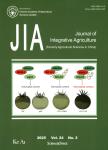Functional characterization of the catalytic and bromodomain of FgGCN5 in development,DON production and virulence of Fusarium graminearum
功能的描述催化并且在开发的 FgGCN5 的 bromodomain,穿上镰刀霉 graminearum 的生产和毒力作者机构:The Key Lab of Integrated Crop Pests Management of Shandong Province/College of Plant Health and MedicineQingdao Agricultural UniversityQingdao 266109P.R.China
出 版 物:《Journal of Integrative Agriculture》 (农业科学学报(英文版))
年 卷 期:2020年第19卷第10期
页 面:2477-2487页
核心收录:
学科分类:09[农学] 0904[农学-植物保护] 090401[农学-植物病理学]
基 金:Supported by the open project of the State Key Laboratory of Crop Stress Biology for Arid Areas Northwest A&F University China(CSBAA2016001)
主 题:FgGCN5 catalytic domain bromodomain DON virulence
摘 要:FgGCN5,a GCN5 homolog in Fusarium graminearum,plays a critical role in hyphal vegetative growth,asexual and sexual reproduction,deoxynivalenol(DON)biosynthesis and plant *** nuclear localized GCN5,four conserved sequence motifs(I-IV)are presented in the catalytic domain and a bromodomain in the *** a lysine acetyltransferase,conserved negatively charged residues are present to neutralize the protons from lysine ***,the role of conserved motifs/domains and residues in FgGCN5 are ***,we generated deletion mutant strains for each the conserved motifs/domains and a glutamate residue 130(E130)replacement *** of each conserved motif in the catalytic domain and replacement of E130 site resulted in manifold defects in hyphae growth,asexual and sexual development,DON biosynthesis,and plant *** defects in the mutant strains were similar to deletion *** deletion of the bromodomain led a significant reduction in DON production and virulence,with no effects on hyphae growth,asexual or sexual ***5 was further found to localize to the nucleus in conidia and hyphae *** conclusion,FgGCN5 encodes a nuclear localized *** conserved motifs in the catalytic domain and E130 are essential for correct functions of the *** conserved bromodomain is impotant for DON production and pathogen *** was the first report to identify the functions of conserved motifs/domains in FgGCN5,which will contribute to our understanding of the mechanism(s)by which FgGCN5 regulates ***.




